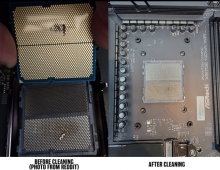
First AMD Ryzen Desktop APUs Featuring Powerful Graphics Released
AMD has officially released the new quad-core Ryzen 5 2400G and Ryzen 3 2200G desktop processors, which combine high-performance Radeon "Vega" architecture with "Zen" CPU Cores on a single chip.
AMD says that the Ryzen 3 2200G and Ryzen 5 2400G APUs are everything budget gamers have been praying for: decent gaming performance at a shockingly low price - $169 USD SEP and $99 USD SEP for the Ryzen 3 2200G and Ryzen 5 2400G, respectively.
| AMD Ryzen 5 2400G | AMD Ryzen 3 2200G | |
|---|---|---|
| CPU Cores | 4 Cores, 8 Threads (1 CCX) | 4 Cores, 4 Threads (1 CCX) |
| CPU Base Clock | 3.6GHz | 3.5GHz |
| CPU Max Boost Clock | Up to 3.9GHz | Up to 3.7GHz |
| CPU L1 Cache | 64K I$, 32K D$ per core | 64K I$, 32K D$ per core |
| L2+L3 Cache | 6MB | 6MB |
| GPU Cores | 11 Radeon Vega Cores (704 ALUs) |
8 Radeon Vega Cores (512 ALUs) |
| GPU Clock | Up to 1250MHz | Up to 1100MHz |
| GPU TMU Count | 44 | 32 |
| GPU ROP Count | 16 (32-bit) | 16 (32-bit) |
| GPU ACE/HWS Count | 4/2 | 4/2 |
| Total FP32 TFLOPS | 1.99 (1.76 GPU/0.231 CPU) | 1.35 (1.126 GPU/0.224 CPU) |
| PCIe Gen3 Lanes | 8x GPU / 4x General / 4x Chipset Link | 8x GPU / 4x General / 4x Chipset Link |
| TDP | 65W | 65W |
| DRAM Support | Up to DDR4-2933 (Dual Channel) | Up to DDR4-2933 (Dual Channel) |
| Die Size and Transistors | 209.78mm2 / ~4.94 billion | |
The Ryzen 3 2200G features four Zen cores without symmetrical multi-threading (SMT), which is AMD's version of Intel's Hyper-Threading. The cores have a base clock of 3.5GHz with a boost clock of 3.7GHz.
The APU also features eight Vega compute units (CUs) inside.
The Ryzen 5 2400G is also a quad-core chip, but with SMT switched on for a total of eight threads of computing power. AMD has increased the base clock to 3.6GHz and the boost clock to 3.9GHz. For graphics, you get about a third more CU's, with 11 Vega units inside.
Both are AM4-based and should work in most AM4 socket motherboards that have display outputs and the latest BIOS available. AMD has also left the new chips unlocked for those who want to explore overclocking (unlocked CPU, GPU, memory, and voltage). AMd is offering AMD Ryzen Master. This is a Windows-based application that gives you full control over the CPU clock speeds, GPU clock speeds, memory clock speeds (and voltages for all). Not everyone is familiar with the BIOS settings, so is offering the AMD Ryzen Master software to make it simple to try your hand at overclocking right from the desktop, and monitor your hardware while you do it.
Compared to the Zen cores used in Ryzen CPUs, the Ryzen APUs feature less cache, half the GPU PCI lanes, and the use of a single, unified CCX in the APU, rather than the dual-CCX design in the current CPU. The decision behind the single, unified CCX design is that AMD needed to save space and make thermal room for the overhead of the Vega cores. Although the sesign lowers total cache, AMD said the practical impact in its own testing was minimal.
AMD says that omproved AMD SenseMI technology enables lower power usage at higher frequencies and reduced memory latencies. The new APUs also support Precision Boost 2, a multi-core boost algorithm that enables higher frequencies in gaming and real-world applications.
According to AMD, the Ryzen 5 2400G processor delivers
- The same graphics performance in a single processor as combining the $199 USD Intel Core i5-8400 with an $89 USD NVIDIA GeForce GT 1030 discrete gaming GPU
- Up to 156% more graphics performance than the Intel Core i5-84007
- Up to 21% more system performance than the Intel Core i5-84008
- Up to 39% faster graphics performance when overclocked
Those claims are not so far from the truth. according to the first benchmarks for the new chips.
The Radeon Vega graphics built into these new processors handle H.264, HEVC, and VP9 fully in the hardware. And when it comes to monitors, Radeon Vega graphics can handle any display up to 4K UltraHD, even if you also throw in High Dynamic Range (HDR) and Radeon FreeSync technology.
This means that AMD could have the chance to make sub-$100 graphics cards obsolete. The APUs seem to have all the package - Vega cores for decent graphics performance, great x86 cores despite the single-threaded lead of Intel's CPUs due to higher clocks, and a price that isn't a punch line.






















